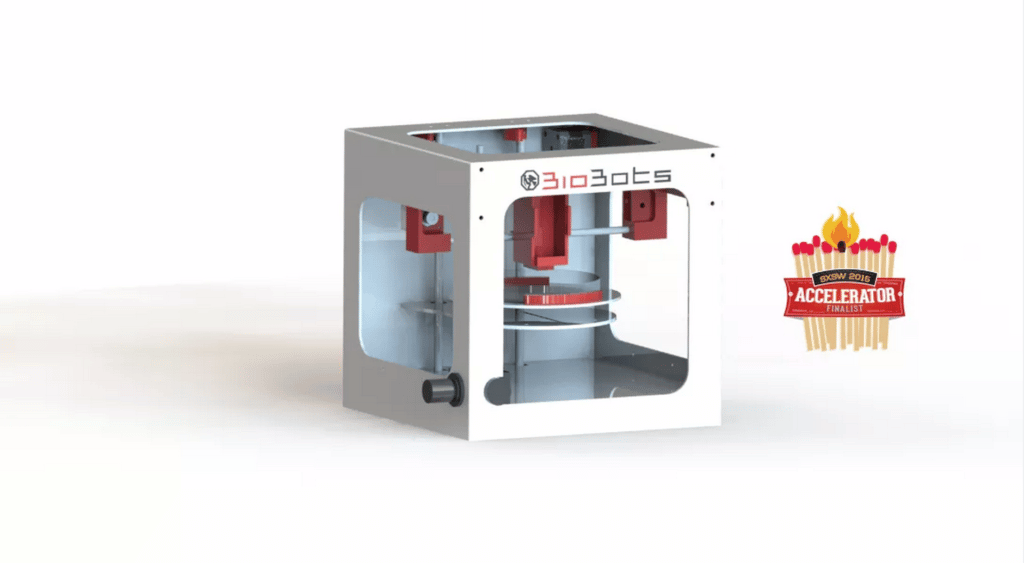After attending SXSW nine times I’ve seen all manner of innovations, from the meaningless to the profound, there. I’ve launched a startup at SXSW in 2013 and even had my work recognized at the Interactive Awards. I want to claim SXSW has lost relevance, and that the marketers have ruined it, but have to admit there are still some wonderful innovations on display.
BioBots
BioBots was, deservedly, recognized as one of the most innovative startups at SXSW.
BioBots offers plug and play desktop 3D bioprinting that enables users to easily make functional three dimensional living tissue from human cells. This has huge potential for medical testing purposes, and possibly eventually for transplants.
Bioprinting involves recreating the 3D structure of a tissue with a fabrication technique using a computer program to slice up the biological structure into discrete layers and rebuild them using some sort of biomaterial extruded from a printhead that can move up, down, and side-to-side.
The 3D printer was invented by Danny Cabrera and Ricardo Solorzano, initially students in Miami Dade College, before they moved on to the University of Pennsylvania. It was in Pennsylvania that they were able to attract funding and begin the development of their project.
Biobots are ultimately focused on further developing their research to enable cost-effective 3D creation of artificial organs. The medical implications of this are profound.
Exiii Robotic Hand
Japanese company, Exiii, brought their first customer to SXSW to demonstrate their product: a prosthetic arm with a robotic hand. The customer had lost his arm two years ago in a factory accident in Japan.
Prosthetics have, of course, been in use for many years. So what’s different about this product. Well, firstly, as far as artificial limbs go, this one is actually quite stylish and futuristic looking.
Secondly, the robotic hand is actually very usable. It has sensors that can detect any movement that muscles make. These sensors send signals to the wearer’s smart-phone, which in turn controls the robotic hand. The hand has many of the movement capabilities of a natural hand, including moving the “fingers” and picking up items weighing up to 500 grams.
Exii have plans of making their prosthetic devices available to be printed at home on a 3D printer. They hope that this will lead to prosthetics being available to everyone who needs one.
Immortality Through Robotics
Martine Rothblatt, America’s highest paid woman and CEO of biotech firm United Therapeutics was recognized as the best speaker at SXSW this year. She has been involved with quite a few projects on the cutting edge of biotech, including using organs from genetically-modified pigs for human organ transplants.
One of the more unusual of her projects however, is that she has hired a team of robotic scientists who have created a robot that is a “mind clone” of her wife, Bina Aspen. Bina’s robotic twin contains a “mindfile” containing many of the original’s mannerisms, personality, memories, feelings, values and attitudes.
In many ways the robotic Bina can mimic the human Bina. “She” can hold a conversation, use social media, express jealousy, “feel” pain and act in a similar way to her human counterpart.
Rothblatt believes that we are about two decades away from the mindfile being developed enough to be real and common, however the development with Bina is advancing fast.
When the human Bina eventually dies, the robotic version will live on. In time “mind clones” might not just be imitations but true clones. Does that mean they’re self aware? If so, does this equate to immortality through transcendence past our own bodies?
A Sexy Turing Test
 The last “mind clone” innovation touched on the concept of self-awareness in machine derived from a human’s mind. In the world of artificial intelligence the concept is a frequent point of discussion. The Turing Test is a method that scientists use to determine if a computer is capable of thinking like a human. This week many at SXSW were exposed to their own form of a Turing Test via a promotion for the excellent new film Ex Machina.
The last “mind clone” innovation touched on the concept of self-awareness in machine derived from a human’s mind. In the world of artificial intelligence the concept is a frequent point of discussion. The Turing Test is a method that scientists use to determine if a computer is capable of thinking like a human. This week many at SXSW were exposed to their own form of a Turing Test via a promotion for the excellent new film Ex Machina.
 Many singles seem to spend a lot of time hanging out on Tinder – swiping left and right to reject or select potential new matches. Those attending SXSW were no exception, and many busily swiped away on Tinder while they were in town hoping to find their perfect match.
Many singles seem to spend a lot of time hanging out on Tinder – swiping left and right to reject or select potential new matches. Those attending SXSW were no exception, and many busily swiped away on Tinder while they were in town hoping to find their perfect match.
Many of the guys were being matching up with an attractive 25-year-old woman named Ava.
Those who wanted to chat to Ava usually found that she would sensibly and intelligently chat with them, and even ask them thought-provoking questions like “What makes you human?” She would then send them to her Instagram account to see more of her. One can only guess what they were hoping to see on Instagram.
What they actually found when they opened Ava’s Instagram account was a photo and video, both of which promoted Ex Machina.
The thing is, this is not just a case of Tinder spam. Ava is actually Swedish actress Alicia Vikander who plays an artificial intelligence in the movie. The marketing while clever gets a nod today due it’s effectiveness in getting it’s audience to pause and consider the underlying message of the movie.
Arousal Detecting Dresses
They may not be entirely new, having first been seen in the world of fashion in 2011, but the Intimacy 2.0 dresses were definitely an eye-opener at SXSW.
These dresses, which are the design of Studio Roosegaarde are definitely high-tech. What is particularly unusual about them, though, is that the material they are fashioned from becomes more transparent the closer they are to people – well at least people that arouse the wearer.
The fabric is embedded with heart rate sensors, and as the heart rate quickens the dress slowly transitions from opaque to partially transparent.
Looking to the future it’s interesting to see other uses for the myriad of biometric sensors that are being added to wearables and smartphones. It was only a matter of time before this data was integrated in a way that was a form of expression. I expect to see these concepts flourish in more conventional clothes in the next year or two.
The original dresses, Intimacy Black and Intimacy White, were made out of smart e-foils, with the “interesting” color-changing effect whenever there were any close and personal encounters. The newer Intimacy 2.0 dresses add leather to the mix and are more suitable for wearing on the red carpet.




